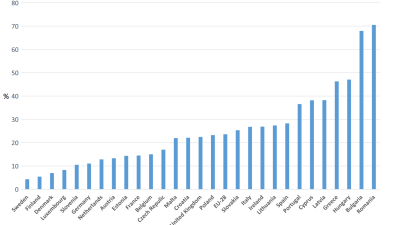Overall, just under a third of adults cannot afford 3 or more of the items and activites seen as necessities for adults and 31% of children went without 2 or more of the child necessities. The pie-charts below show (1) the employment status of these deprived adults, (2) household work status and (3) the family type of deprived children.
The list of necessities for adults and for children included in the counts can be found at the bottom of the
Deprivation tables page.
Chart 1: Deprived adults by employment status
Download csv file
Source: PSE UK 2012
Overview
Over half of adults (52%) who are deprived on this measure are in work, mostly full time (39%), some part-time (13%). By contrast, the unemployed constitute only 12% of adults in deprivation, and the sick or disabled 11%.
Most of the 10% who are looking after the family/home will be in households where someone else in the household is in work (for example, one parent working while the other stays at home to look after the children or another dependent). Similarly, some of those who are sick and disabled, retired or students will be in households where someone else in the household is in work. The proportion of adults who are deprived who are in households where at least one member of the household is in work is higher that the proportion as classified by the individual themselves - close to 60%.
Being in work, or being in a household where someone is in work, is increasingly not sufficient to keep members of that household from being deprived.
For further discussion on the PSE's findings on poverty and work see: 'Exclusionary employment in Britain’s broken labour market' by Nick Bailey in Critical Social Policy, February 2016, 36: 82-103
Chart 2: Deprived children by household work status
Download csv file
Source: PSE UK 2012
Overview
Most children who lack 2 or more child necessities are in households where adults work: 63% are in households where at least one adult works at least some of the time, with 45% in households where at least one adult works full-time. The proportion in households where all the adults work full-time (18%) is considerably higher than the proportion in households where all the adults are unemployed (7%).
For further discussion on the work status of families with children in poverty see: the PSE:UK final report on ‘Child poverty and Social exclusion’ by Gill Main and Jonathan Bradshaw.
Chart 3: Deprived children by family type
Source: PSE UK 2012
Overview
This chart shows that the largest group of children who are deprived live in two parent, two children households (28%) and that most children who are deprived live with two parents/adults (58%). The ‘other’ group above will include two parent households where the older children are over the age of 18.
For further discussion on the family type of families with children in poverty see: the PSE:UK final report on ‘
Child poverty and Social exclusion’ by Gill Main and Jonathan Bradshaw.
Further information
For further discussion on the composition of the poor and trends over time see: 'Breadline Britain – the rise in mass poverty', by Stewart Lansley and Joanna Mack (Oneworld, 2015, £9.99).
Survey details
See PSE survey details for the sampling size and frame of the PSE UK 2012 Living Standards survey and the PSE UK 2012 Necessities of Life survey.
First posted: 1 June, 2016
Author: Joanna Mack



 PSE:UK is a major collaboration between the University of Bristol, Heriot-Watt University, The Open University, Queen's University Belfast, University of Glasgow and the University of York working with the National Centre for Social Research and the Northern Ireland Statistics and Research Agency. ESRC Grant RES-060-25-0052.
PSE:UK is a major collaboration between the University of Bristol, Heriot-Watt University, The Open University, Queen's University Belfast, University of Glasgow and the University of York working with the National Centre for Social Research and the Northern Ireland Statistics and Research Agency. ESRC Grant RES-060-25-0052.






